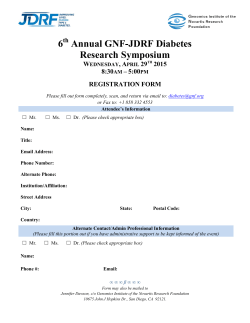
Challenges of Big Data in Health
Challenges of Big Data in Health Toshiba – JH Collaboration Scott L. Zeger Professor and Director Johns Hopkins inHealth Initiative © 2014 Hopkins inHealth • 40 year old man, no family history, tests “positive” in a cancer screening test • What is his cancer state? Data from population of “similar” people True cancer status Test result Yes No Total Positive 15 985 1,000 Negative 5 8,995 9000 Total 20 9,980 10,000 © 2014 Hopkins inHealth © 2014 Hopkins inHealth “Big Data” – large, complex data sets that challenge current data science knowledge/skills that hold out the promise of hidden truths –> “data mining” for “gold” © 2014 Hopkins inHealth Boole - a - Bayes Thomas Bayes 1701-1761 George Boole 1815-1864 © 2014 Hopkins inHealth Radar to Land Aircraft Safely at BWI N Measurements Symbol of type of aircraft Smoothed track updates Initial Radar Measurements (radar echoes) Filtered (smoothed) “track” updates Indicates expected future direction and speed © 2014 Hopkins inHealth Tracking through changing trajectory Display of altitude Data: Track No. 1234 Position (x,y,z) Speed and direction Acceleration Identification Track State Analogy location genotype velocity phenotype acceleration environment/behavior accuracy uncertainties biomarkers/labs/ images identification identification © 2014 Hopkins inHealth Clinical and Public Health Discovery Improved Health at More Affordable Costs Scale and replicate Scale and replicate Biohealth Pilot Projects Cancer screening OncoSpace in Radiation Oncology Population Health Demonstration Cancer screening and early diagnosis Obesity and Diabetes Children’s asthma prevention and control Cardiovascular disease diagnosis and treatment Management of autoimmune diseases Cardiovascular disease Genomics of cystic fibrosis Myostatin in sarcopenia Age-related cognitive loss Telomere biology and chronic diseases Methodology Cores Health measurement Bioethics Big Data and software solutions Statistical design and analysis © 2014 Hopkins inHealth Behavior change and dissemination Finance – organization models A data system designed to individualize radiation therapy Todd McNutt, Kim Evans, Joe Moore, Harry Quon, Joseph Herman, Andrew Sharabi, Wuyang Yang, John Wong, Theodore DeWeese Disclosure: Funding from Elekta and Philips © 2014 Hopkins inHealth Sample Automated Radiation Plan Original plan Automated plan 30% reduction in dose to parotids 1 0.9 0.8 Auto plan Original Plan Dot: right No-dot: left 0.7 0.6 0.5 0.4 0.3 0.2 0.1 0 0 10 20 30 40 Dose(Gy) 50 60 70 10 © 2014 Hopkins inHealth 80 © 2014 Hopkins inHealth Model Framework for Infections (I) and Pathogen Blood LytA PCR Measurements (M) measure, M B,PCR External to the lung Blood infection, IB A/C antibodies measure MSERA NP measure MNP, PCR NP INP NP measure Mnp, CX Blood culture measure, MB,CX Sputum ISP Lung aspirate culture and PCR measure*, ML,CX and ML,PCR Sputum measure MSP, CX Gastric aspirate*§ MGA, TB CX Pleural fluid culture and PCR measure*, MPF, CX and MPF, PCR * collected on a subset of cases § TB testing only Sputum measure MSP, PCR © 2014 Hopkins inHealth Measurement of pathogen/evidence of infection Pathogen direction of travel Potential non-pneumonia causes of pathogen detection Sample collected in both cases and controls Unknown regression coefficient γ Covariates for adjustment (X) Population Pathogen Distribution Unobserved Lung Infection (I) Infection Measurements (M) Prob(M|Case) Prob(M|Control) © 2014 Hopkins inHealth Clinical Pneumonia (Y) DRAFT © 2014 Hopkins inHealth DRAFT © 2014 Hopkins inHealth DRAFT © 2014 Hopkins inHealth All that glitters…. © 2014 Hopkins inHealth Beware the Texas Sharpshooter © 2014 Hopkins inHealth Congratulations to Toshiba Welcome to Johns Hopkins! Thank You © 2014 Hopkins inHealth
© Copyright 2025










